by Craig Brelsford
Founder, shanghaibirding.com

In May 2024 I birded the Lesser Khingan Mountains in Heilongjiang, China. My team also covered the Sino-Russian border along the Amur River and the Guokui Mountains in Boli, my wife Elaine Du’s hometown in southeast Heilongjiang. Birding in China for the first time in 6½ years, Elaine and I picked up right where we’d left off, this time with our children, “Tiny” Craig, age 6, and Phoebe, 3, as partners.
Our biggest accomplishment came along the Amur, where we documented the continuing eastward expansion of Great Tit in China. (Read report here.) Wuying National Forest Park, our base in the Lesser Khingans, yielded Japanese Sparrowhawk, Northern Hawk-Cuckoo, and White’s Thrush. We submitted the first list on eBird for Xinqing National Wetland Park, where we had Oriental Stork and Siberian Roe Deer. In Boli, Wushun River National Forest Park, explored extensively by Elaine and me in 2015 and 2016, was closed for renovations. We birded the thickly wooded hills outside the park, finding there Mandarin Duck, Eurasian Eagle-Owl, and a group of possibly feral Manchurian Sika Deer.
Birding 13 of the 16 days between 18 May and 2 June, we recorded 85 species. Our birding locations stretched from Boli 400 air-km (250 air-mi.) northwest to the Amur in Yichun Prefecture. (See map below.) Many species, among them Eastern Buzzard, White-backed Woodpecker, and Daurian Redstart, we recorded throughout this vast area. Others, such as Yellow-rumped Flycatcher and Blue-and-white Flycatcher, we recorded around Boli and along the Amur but not in the Lesser Khingans. Still others, such as Eurasian Siskin and Eurasian Bullfinch, we found only in the Lesser Khingans.
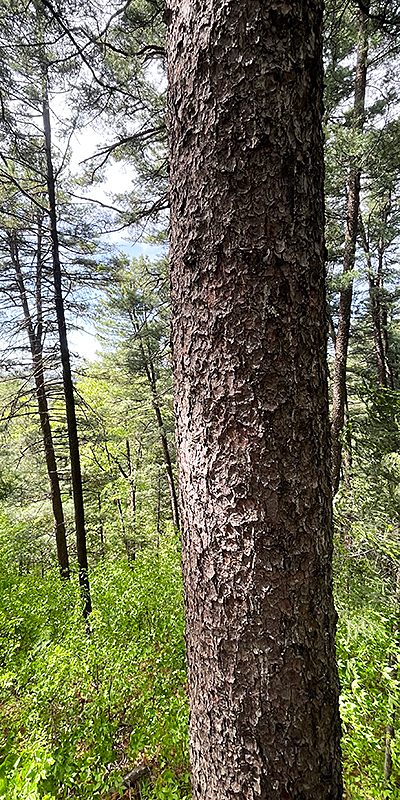
For a birder new to the Lesser Khingans, an ideal place to start is Wuying National Forest Park (48.204400, 129.207322). The park sits in the heart of the range and contains the mixed broadleaf-conifer forest and low, rounded mountains characteristic of the region. The lodge where we spent five nights is at an elevation of 430 m (1,390 ft.). Massive Korean Pine Pinus koraiensis rise throughout the park. The air is remarkably clean. During our visit, from 23 to 28 May, the air-quality index was usually under 20.
Birding begins the moment one steps outside the lodge. Mugimaki Flycatcher were singing throughout the day. Nearly as constant were the songs of Common Cuckoo and Oriental Cuckoo, the latter’s sonorous boop-boop coming from unseen singers at the tops of the highest trees. Also invisible in the canopy but conspicuous by their songs were Pale Thrush and Grey-backed Thrush. From mid-canopy we heard Siberian Thrush, from the lower branches Pale-legged Leaf Warbler and Tristram’s Bunting, and from the ground Siberian Blue Robin and Rufous-tailed Robin.
We witnessed birds at various stages of the breeding cycle. Just above a bank of unmelted snow along a stream, we found a Eurasian Wren already fledging. A Eurasian Bullfinch was flycatching, gleaning protein for its young. Other species were only just establishing breeding territories. My long wait for White’s Thrush ended two hours before dawn on our final day when, through our window hopefully left open, I heard its mysterious one-note song.
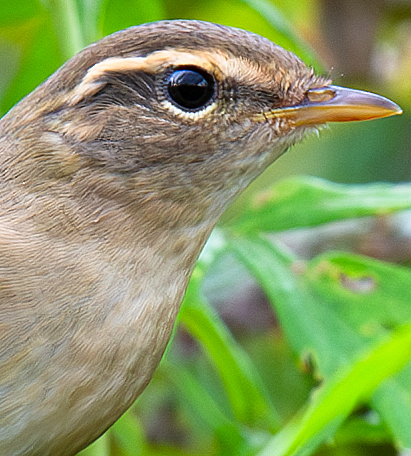
The forest yielded many other Northeast China breeders. We noted daily Radde’s Warbler, Pallas’s Leaf Warbler, and Black-faced Bunting and had records of Ashy Minivet, Eurasian Nuthatch, Gray’s Grasshopper Warbler, White-throated Rock Thrush, Dark-sided Flycatcher, and Asian Brown Flycatcher. Open areas gave us Brown Shrike, Amur Stonechat, Amur Wagtail, Grey Wagtail, and Olive-backed Pipit.
The forest was cool, quiet, nearly free of mosquitoes, and infested with ticks. We rarely ventured off the sturdy new boardwalks, which wind for miles through the park. One particularly good boardwalk climbed a ridge to a large pavilion. We peered through stands of Korean Pine to see rounded green mountains rippling to the horizon.
For Elaine and me, Wuying was the latest in a long line of hidden treasures that she and I have discovered in China. Few birders visit the ornithologically important park, as the lack of records on eBird shows. In fact, few visitors reach Wuying at all, at least in late May. The roads and shuttle buses were mostly empty, and throughout our stay we had the lodge to ourselves.

The lodge, set deep in the forest, and with trails, boardwalks, and paved roads leading from it in all directions, was the perfect base of operations. We hardly would have needed our car, which in any case we had to leave at the entrance to the park. The home cooking was excellent and included wild greens which the staffers despite the ticks were happy to harvest from the surrounding woods. Everyone treated us like dignitaries.
On 28 May we left Wuying and drove north in our rented Tank 300. In a steady rain we explored Xinqing National Wetland Park (48.318175, 129.576232), finding there Garganey and Falcated Duck plus breeding Thick-billed Warbler and Dusky Warbler. The views of the Oriental Stork and Siberian Roe hinted at the richness of the reserve. Under better viewing conditions this reserve surely would yield more birds than we were able to see. In the nearby town of Tangwang River we had Common Sandpiper, Eurasian Sparrowhawk, and Marsh Tit.

We pressed ever northward. Our goal: to record Great Tit at a point in Chinese territory farther east than anyone on eBird had recorded it before. We believed that our best chance to accomplish this feat would come not in the thickly forested Lesser Khingans but in the towns, farms, and open woodland along the Amur River.
Our search covered three days, 29–31 May. We drove 90 km (56 mi.) along the middle Amur, from Jiayin Dinosaur Park in the east to the northwest edge of Jiayin County and Yichun Prefecture. The setting is dramatic. The mighty Amur, third-longest river in China, 10th-longest in Asia, is ever near. The Manchurian sky is big, deep blue with tall white clouds, brightened by a northern sun that in late May at that latitude shines 16 hours a day. The land, the northern slope of the Lesser Khingans, is hilly, ranging in elevation from 100–200 m (330–660 ft.). Fields alternate with oaky forest.
Locals told us of the pair of Siberian Tiger that had crossed the frozen river the previous winter, stayed on the Chinese side after the river thawed, and had been killing sheep and cows. Signs warned of the tigers. We stayed close to the Tank.
To avoid suspicion near the international border, before entering towns, I would disassemble my camera and lens, stow my spotting scope, and collapse and store my tripod. In Wuyun Town this strategy paid off. After we checked in, the receptionist at our hotel reported to the police that foreigners were staying there. Two officers met us in the lobby. “What are you doing here?” one asked. “I’m a tourist exploring my wife’s home province with our children,” I said. Had my big lens and telescope been open to view, the officers might have doubted my story.
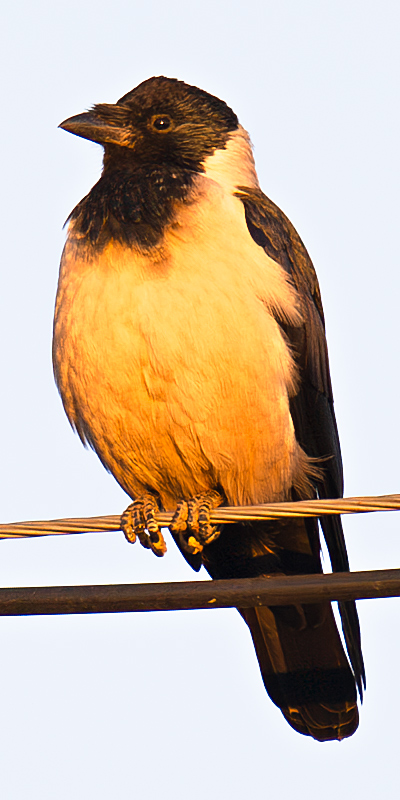
Unwilling to bird in towns, wary of tigers in the country, we spent half the day 29 May and the entire next day searching fruitlessly for Great Tit. Along the way we picked up more good birds. At Wuyun River Bridge (48.972709, 129.961132) we had Daurian Jackdaw, Chestnut-flanked White-eye, and Japanese Tit. Elsewhere we had singing White-throated Rock Thrush and Blue-and-white Flycatcher. In fields along the road we saw Eurasian Hoopoe, and a nighttime drive gave us Grey Nightjar.
That night, 30 May, exhausted but cheerful, resigned to having missed our target species, we pulled into a hotel in an imposing, castle-like building on the outskirts of a village. Only the next morning, pinpointing our location on the map on my iPhone, did I realize that our hotel was a stone’s throw from the Amur. I walked outside and found a large vegetable garden lined with trees. The garden, cool temperatures, and angle and intensity of the sun stimulated a memory in me.
“Europe,” I said. “Great Tit.”
I played back a sound-recording of Great Tit. A splendid male responded.
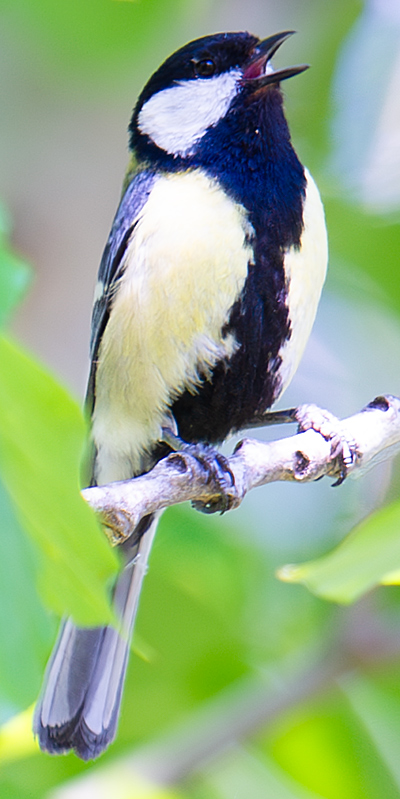
I rushed back to the room, assembled my camera, and hurried outside, too excited to care whether any police saw me. Elaine, Tiny, and Phoebe followed, binoculars in hand. In the final moments of the final day of our search, we achieved a photographic record of China’s easternmost Great Tit. The species likely occurs farther east on Chinese territory, but at that moment no one had recorded publicly on eBird a sighting that far east in China of the famous trans-Eurasian garden bird.
Domestic issues were pressing. Tiny had lost a tooth, and we had a 10-hour drive back to Boli to be on time for Phoebe’s 4th birthday party the next day. We joyfully left Amurland and retraced our path south, across the Lesser Khingans. As I drove, I looked through the rear-view mirror at the cabin of the spacious Tank. There was Elaine, my longtime partner, and around her the same lens, scope, tripod, and even backpack that I had been using years ago. All looked the same—except for the two new partners giggling in the back seat.
We arrived that night in Boli, Elaine’s hometown and the place where the trip had started two weeks earlier. Now began again the joyous family reunion that had started 17 May, the day we arrived in Boli. It had been 6½ years since Elaine and I had left Shanghai, and nearly 8 since we had seen her hometown. Everyone in Elaine’s large family wanted to meet the children and see Elaine again.
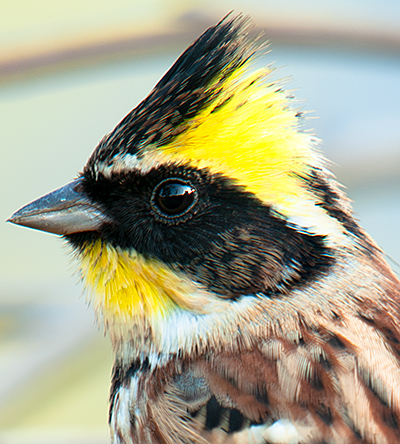
Though birding was now taking a back seat to family, we still managed to accomplish much in Boli. Like the Lesser Khingans, the Guokui Mountains are rounded and low. Being farther south, however, they offer a forest less coniferous and more temperate than the quasi-boreal Lesser Khingans. Among the birds we recorded just outside Wushun River National Forest Park (also known as Xidaquan National Forest Park) were Hill Pigeon, Grey-headed Woodpecker, Hawfinch, Siberian Long-tailed Rosefinch, and Yellow-throated Bunting. We had races that in China occur exclusively or nearly exclusively in the Northeast, among them Eurasian Jay ssp. brandtii, as well as races that occur in Europe and whose ranges span Eurasia, among them Coal Tit ssp. ater and Long-tailed Tit ssp. caudatus. Prominent members of the dawn chorus were Eastern Crowned Warbler, Yellow-rumped Flycatcher, Blue-and-white Flycatcher, Rufous-tailed Robin, Siberian Blue Robin, and Siberian Thrush. The reservoir south of town, which one passed on one’s way from urban Boli to the mountains, gave us records of Mandarin Duck, Grey Heron, and Great Crested Grebe. We had Oriental Greenfinch in the hills as well as our apartment complex in the inner city. A quarry near the reservoir, cut out of the side of a mountain and creating a sheer cliff face, gave us our record of Eurasian Eagle-Owl.
The very best day in those mountains was our first—18 May, the day we took our children birding in China for the first time and greeted those hills like an old friend. We birded the roads approaching Wushun from the north out of urban Boli. At the checkpoint near the entrance to Wushun, we met a ranger who remembered Elaine and me. Even though we had not made it into the park, our mood was upbeat. The moment in 2015 when Elaine and I had first laid eyes on Wushun and the bird-rich roads leading to it, we knew we had found a permanent birding home, a place we would visit every time we returned to Boli. We even said that one day we would take our own children there, and now that dream had come true.

I spent many mornings alone in those mountains. A typical morning was 20 May. I arrived at my accustomed spot before sunrise. In four hours I scratched out 20 species. Few birds were venturing out into the open, and many were heard only—Lanceolated Warbler, Pale-legged Leaf Warbler, and of course Oriental Cuckoo. Many species were absent, among them Northern Hawk-Cuckoo, Grey Nightjar, and White’s Thrush. The only member of Paridae that I found was a Coal Tit on the ridgetop, seen through my spotting scope.
In pursuit of a Yellow-rumped Flycatcher, I almost stepped on a Tristram’s Bunting. The forest bunting was taking tiny flights close to the ground in thick vegetation, rustling the undergrowth like a mouse. The bunting alighted on a perch inches off the ground, and I had to step back to get within the minimum focal distance to take the picture. What a joy it was to get that image, and what a joy it was to be birding China again.
On the morning of 2 June I birded those hills one last time. As I drove back to Boli, I reflected on the previous three weeks. My days as a full-time birder and China insider were over. However, in the Lesser Khingans I had continued my tradition of opening up underbirded areas, and my work with the Great Tit recalled earlier dogged pursuits and last-minute victories (Brelsford 2016, Brelsford 2019). Much in my life had changed, but the fire of birding still burned.
“I am still an Asian birder,” I said.
The next day, I dropped off the Tank at Jiamusi airport and flew to Beijing, whence I took a flight to Orlando via San Francisco. Elaine and the children stayed in China until mid-July.
BIRDS NOTED (AND MISSED)
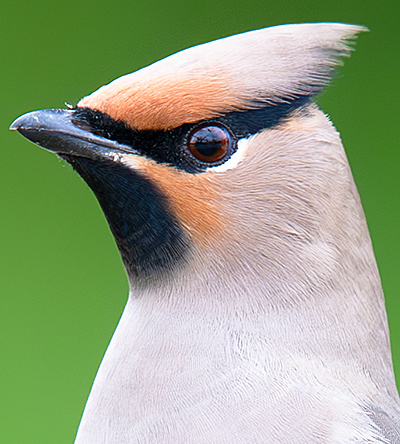
In the Lesser Khingans, despite a diligent search we failed to find Siberian Jay and Two-barred Crossbill. We think those mountains also hold Black-billed Capercaillie, Great Grey Owl, Boreal Owl, Eurasian Three-toed Woodpecker, and Japanese Pygmy Woodpecker. The ranges of Azure Tit, Northern Wheatear, and House Sparrow may reach the Lesser Khingans, but we were unable to prove this. We missed Japanese Waxwing, reported to be an irregular breeder in the Lesser Khingans (MacKinnon 2022, 257). To our continued surprise, Elaine and I have yet to record Red-flanked Bluetail in Heilongjiang.
Below is the list of birds our team noted in May and June 2024 in Heilongjiang. Hyperlinks connect to entries in my Photographic Field Guide to the Birds of China, published in its entirety on this website.
Mandarin Duck Aix galericulata
Garganey Spatula querquedula
Falcated Duck Mareca falcata
Eastern Spot-billed Duck Anas zonorhyncha
Mallard A. platyrhynchos
Eurasian Teal A. crecca
Common Pheasant Phasianus colchicus
Rock Dove (Feral Pigeon) Columba livia
Hill Pigeon C. rupestris
Oriental Turtle Dove Streptopelia orientalis
Northern Hawk-Cuckoo Hierococcyx hyperythrus
Common Cuckoo Cuculus canorus
Oriental Cuckoo C. optatus
Grey Nightjar Caprimulgus jotaka
Pacific Swift Apus pacificus
Common Sandpiper Actitis hypoleucos
Wood Sandpiper Tringa glareola
Great Crested Grebe Podiceps cristatus
Oriental Stork Ciconia boyciana
Great Cormorant Phalacrocorax carbo
Grey Heron Ardea cinerea
Japanese Sparrowhawk Tachyspiza gularis
Eurasian Sparrowhawk Accipiter nisus nisosimilis
Eastern Buzzard Buteo japonicus
Eurasian Eagle-Owl Bubo bubo ussuriensis
Eurasian Hoopoe Upupa epops
Common Kingfisher Alcedo atthis
White-backed Woodpecker Dendrocopos leucotos
Grey-headed Woodpecker Picus canus
Ashy Minivet Pericrocotus divaricatus
Brown Shrike Lanius cristatus confusus
Eurasian Jay Garrulus glandarius brandtii
Azure-winged Magpie Cyanopica cyanus
Oriental Magpie Pica serica
Daurian Jackdaw Coloeus dauuricus
Large-billed Crow Corvus macrorhynchos
Coal Tit Periparus ater ater
Marsh Tit Poecile palustris brevirostris
Great Tit Parus major kapustini
Japanese Tit P. cinereus minor
Thick-billed Warbler Arundinax aedon
Gray’s Grasshopper Warbler Helopsaltes fasciolatus
Lanceolated Warbler Locustella lanceolata
Barn Swallow Hirundo rustica
Siberian House Martin Delichon lagopodum
Asian House Martin D. dasypus
Eastern Red-rumped Swallow Cecropis daurica daurica
Yellow-browed Warbler Phylloscopus inornatus
Pallas’s Leaf Warbler P. proregulus
Radde’s Warbler P. schwarzi
Dusky Warbler P. fuscatus
Eastern Crowned Warbler P. coronatus
Pale-legged Leaf Warbler P. tenellipes
Long-tailed Tit Aegithalos caudatus caudatus
Chestnut-flanked White-eye Zosterops erythropleurus
Eurasian Nuthatch Sitta europaea amurensis
Eurasian Treecreeper Certhia familiaris
Eurasian Wren Troglodytes troglodytes
White’s Thrush Zoothera aurea
Siberian Thrush Geokichla sibirica sibirica
Grey-backed Thrush Turdus hortulorum
Pale Thrush T. pallidus
Dark-sided Flycatcher Muscicapa sibirica sibirica
Asian Brown Flycatcher M. dauurica
Blue-and-white Flycatcher Cyanoptila cyanomelana
Rufous-tailed Robin Larvivora sibilans
Siberian Blue Robin L. cyane
Yellow-rumped Flycatcher Ficedula zanthopygia
Mugimaki Flycatcher F. mugimaki
Daurian Redstart Phoenicurus auroreus
White-throated Rock Thrush Monticola gularis
Amur Stonechat Saxicola stejnegeri
Eurasian Tree Sparrow Passer montanus
Grey Wagtail Motacilla cinerea
White Wagtail M. alba leucopsis
Olive-backed Pipit Anthus hodgsoni
Hawfinch Coccothraustes coccothraustes
Siberian Long-tailed Rosefinch Carpodacus sibiricus
Eurasian Bullfinch Pyrrhula pyrrhula cineracea
Oriental Greenfinch Chloris sinica ussuriensis
Eurasian Siskin Spinus spinus
Yellow-throated Bunting Emberiza elegans
Black-faced Bunting E. spodocephala spodocephala
Tristram’s Bunting E. tristrami
MAP
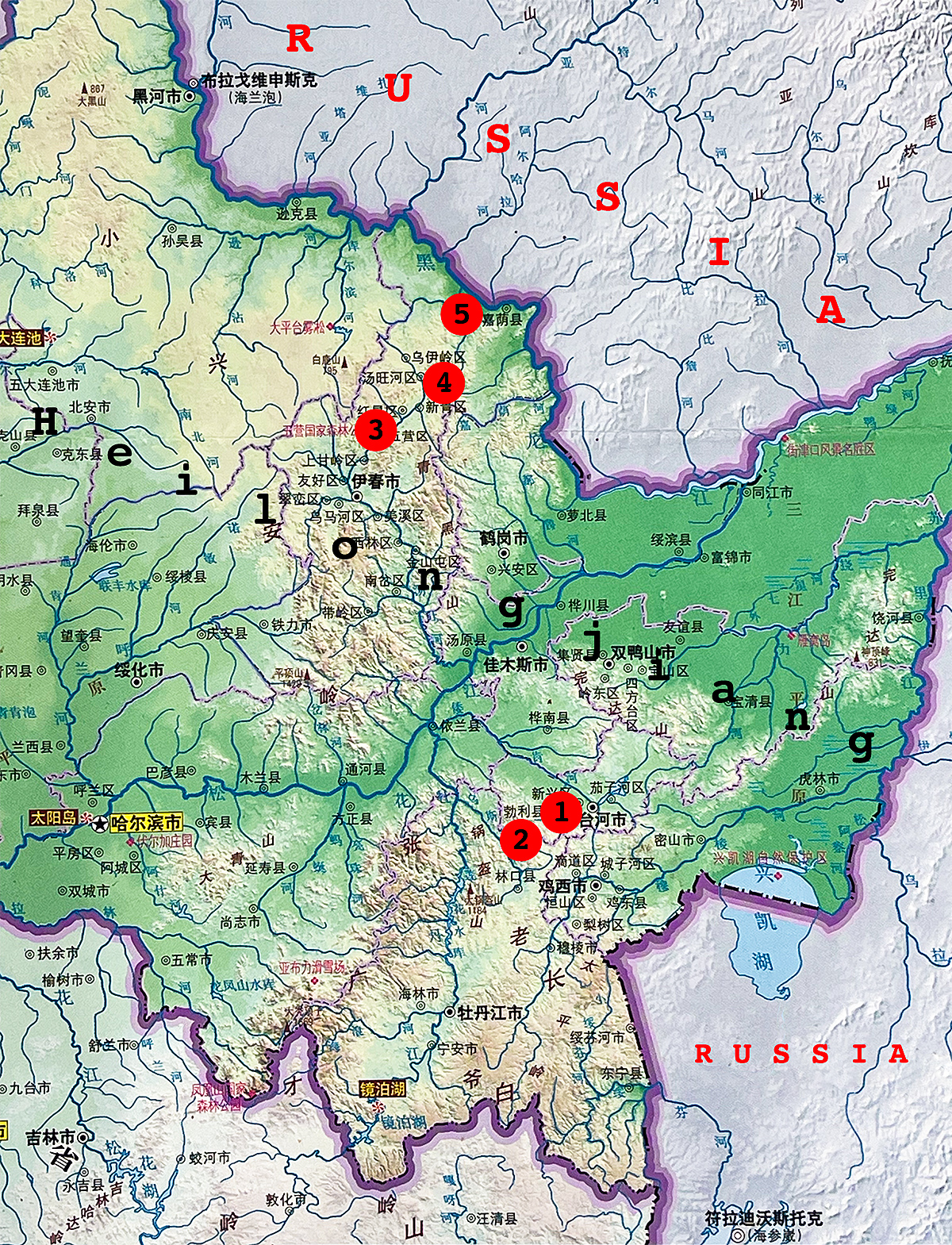
PHOTOS

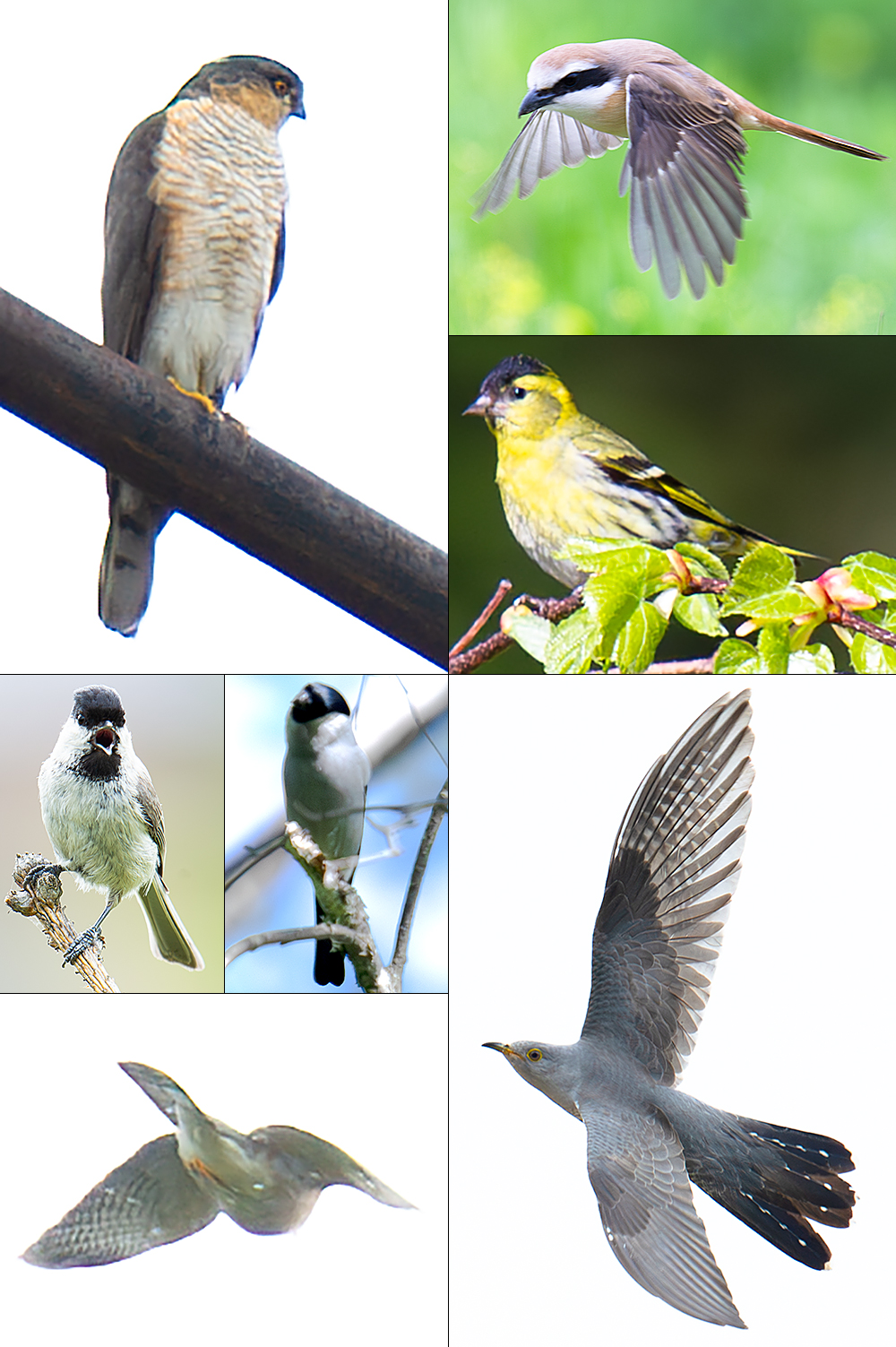
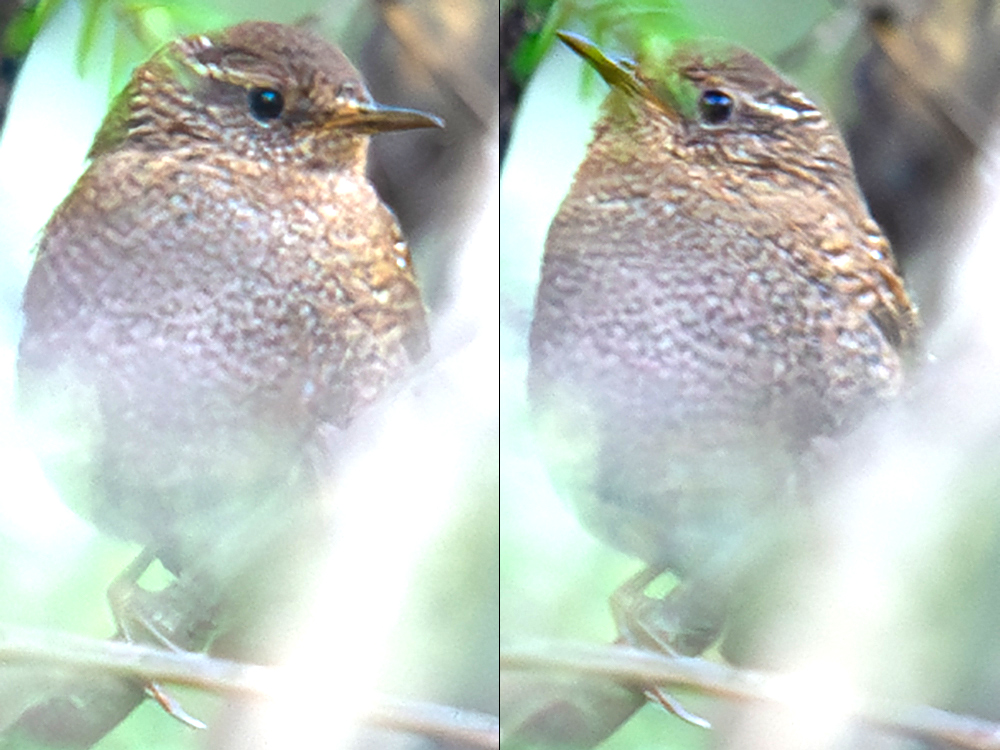

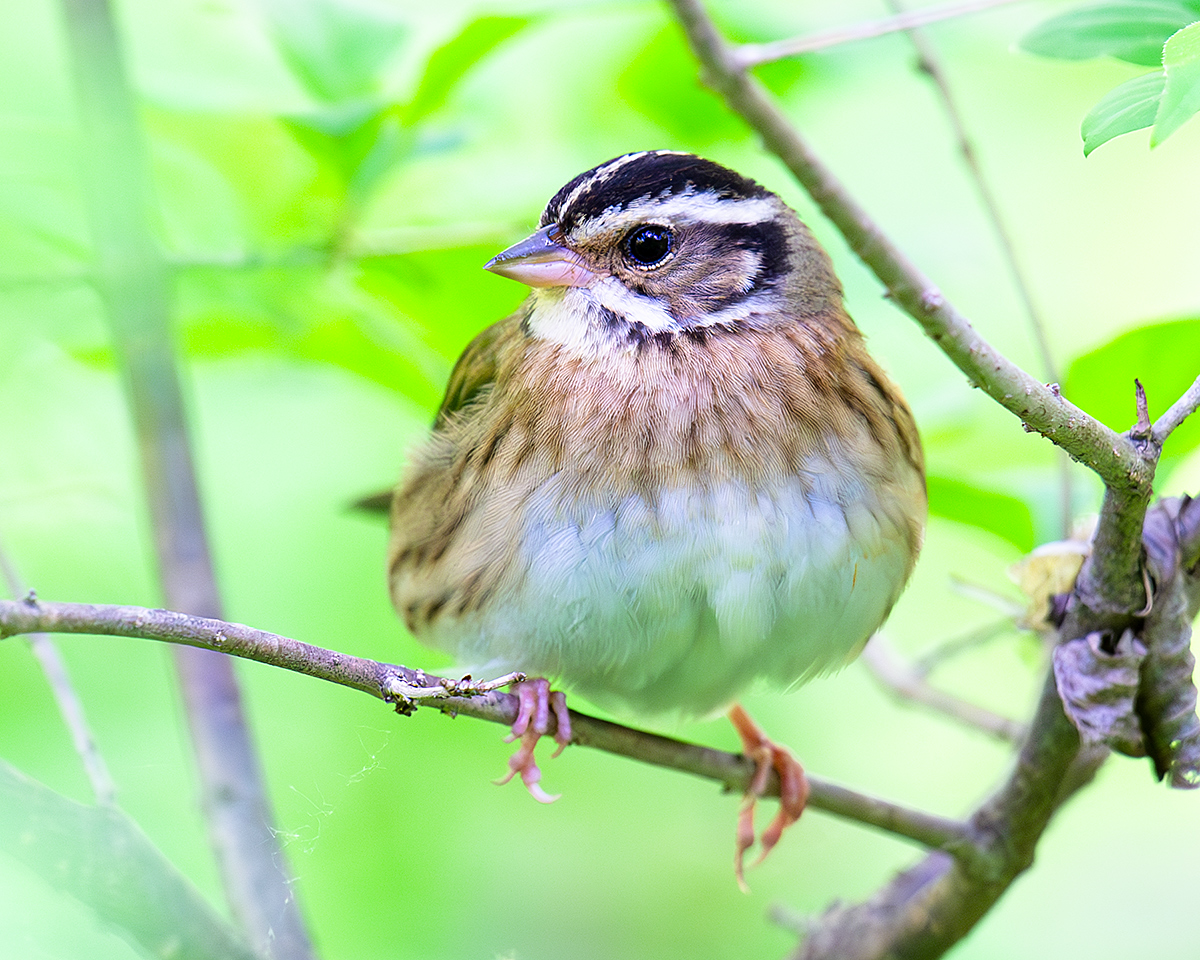
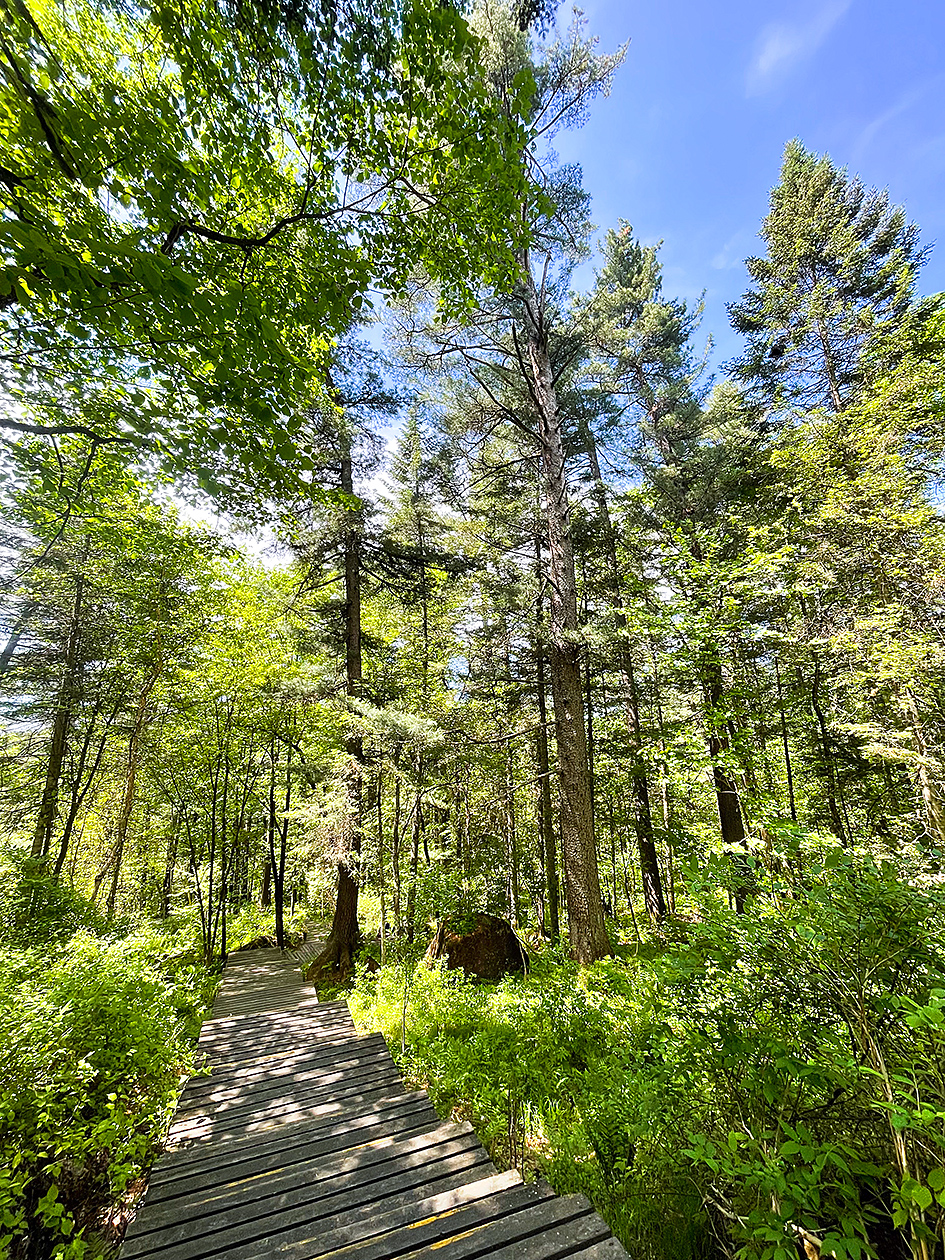
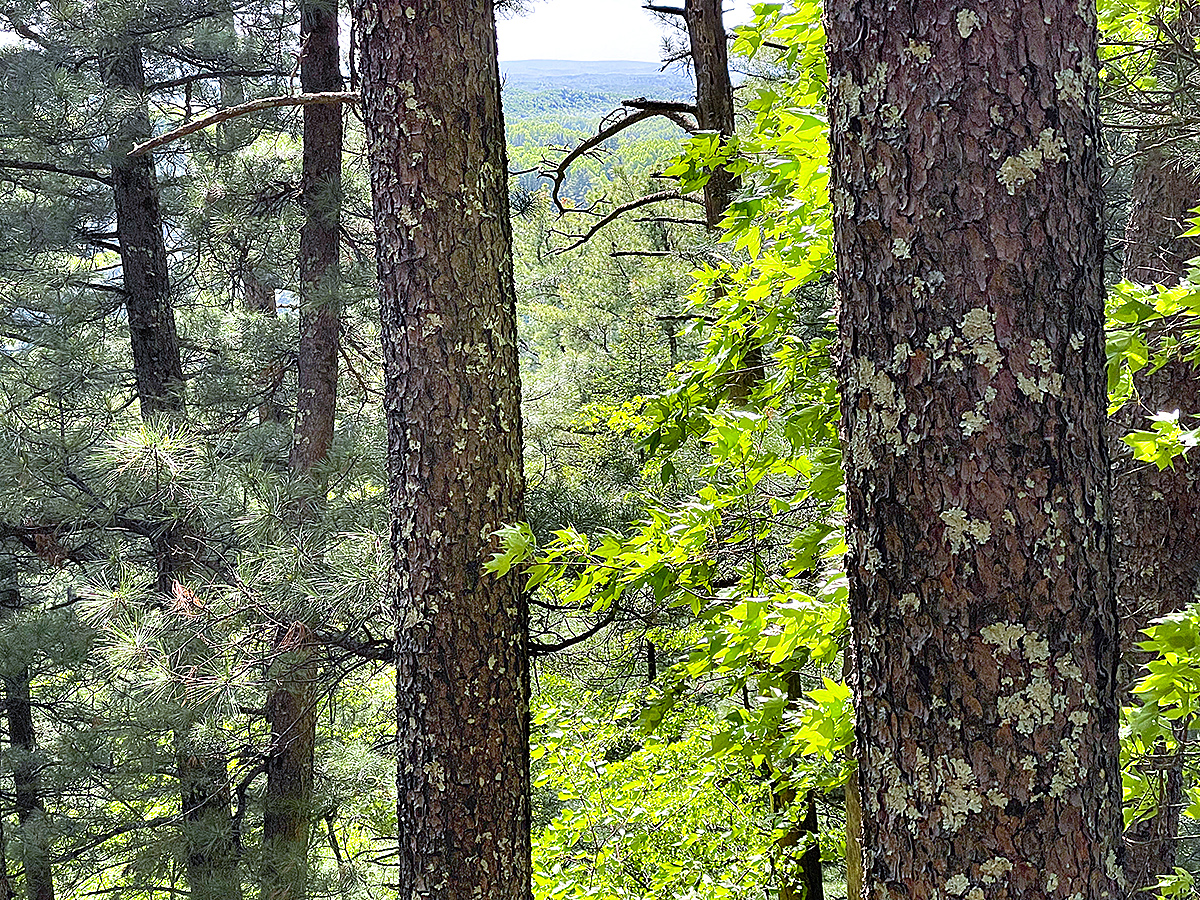




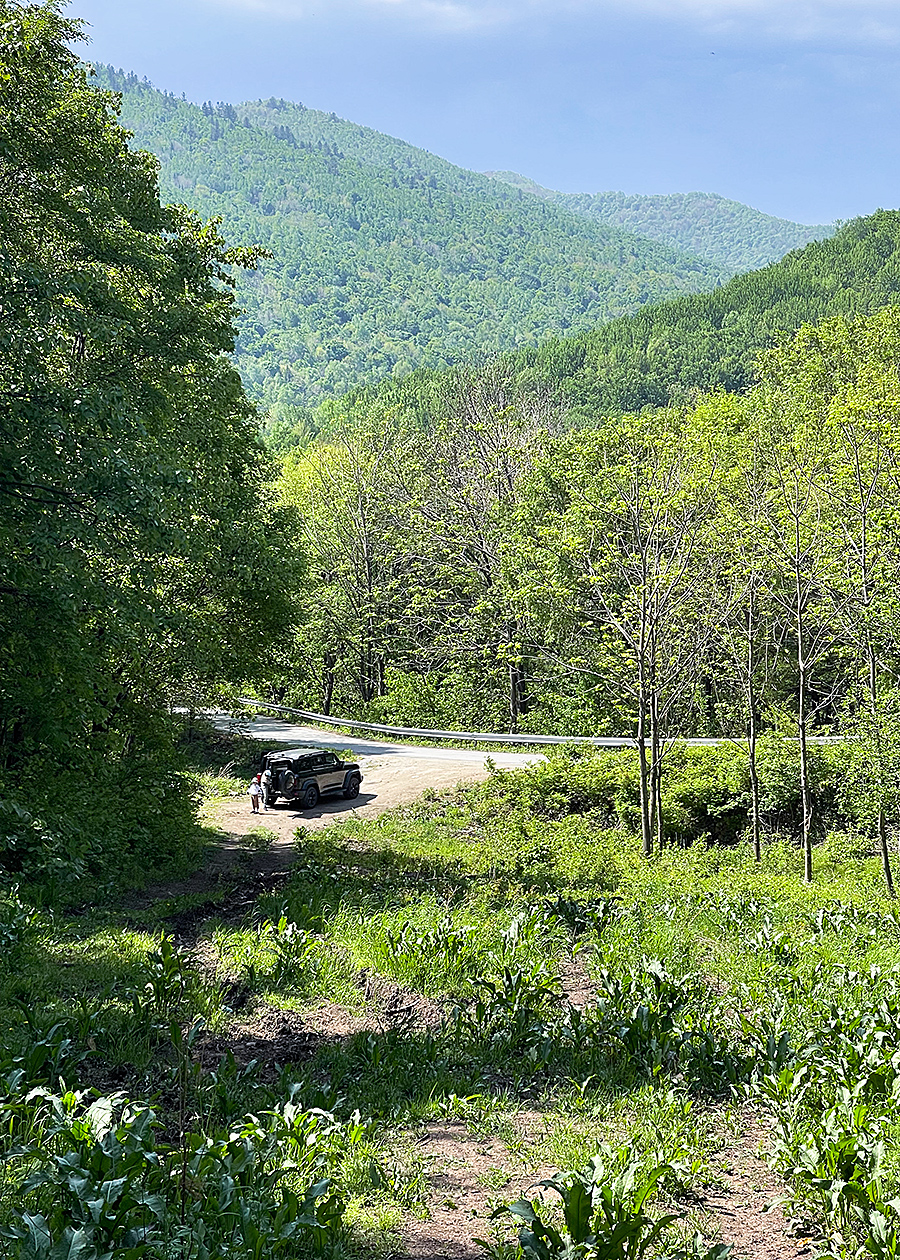















SOUND-RECORDINGS
Siberian Thrush Geokichla sibirica sibirica, song, Wuying National Forest Park (48.248586, 129.215242), Heilongjiang, elev. 460 m (1,500 ft.), 27 May, by Craig Brelsford (2:27; 27 MB)
White’s Thrush Zoothera aurea aurea, song, Wuying National Forest Park (48.248586, 129.215242), elev. 460 m (1,500 ft.), 28 May, by Craig Brelsford (2:15; 25 MB). Most prominent bird in background is Siberian Thrush.
Mugimaki Flycatcher Ficedula mugimaki, song, Wuying (48.255526, 129.201887), elev. 430 m (1,410 ft.), 24 May, by Craig Brelsford (0:49; 9 MB)
VIDEOS (on YouTube)
• A Drive Along the G222 in the Lesser Khingan Mountains, Yichun, Heilongjiang, by Craig Brelsford
• A Drive Along the C933 in the Guokui Mountains near Wushun River National Forest Park, Boli, Heilongjiang, by Craig Brelsford
BIBLIOGRAPHY
Brelsford, C. A Minor Role in a Major Discovery (https://www.shanghaibirding.com/himalayan-thrush/). Post to shanghaibirding.com published 22 Jan. 2016 (accessed: 28 Apr 2025).
Brelsford, C. Birding Northern Xinjiang: Introduction (https://www.shanghaibirding.com/xinjiang-intro/). Post to shanghaibirding.com published 15 December 2018 (accessed: 28 Apr 2025).
Brelsford, C. Rare Photos of Female Firethroat (https://www.shanghaibirding.com/firethroat/). Post to shanghaibirding.com published 16 May 2019 (accessed: 28 Apr 2025).
MacKinnon, John. Guide to the Birds of China. Oxford University Press, 2022.
South China Morning Post. Chinese villager narrowly escapes wild tiger attack. Video, 1:17. YouTube, posted by South China Morning Post, 20 November 2024. https://youtu.be/q4UzpCQhyzk?si=fE1E2d94BoHOKueY (accessed: 6 Apr 2025).
FURTHER READING
shanghaibirding.com offers the world’s most complete coverage of birding Heilongjiang, Northeast China, Siberia, and the Russian Far East. Click any link:
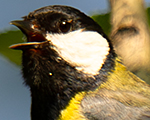
• Great Tit, New Eastern Record: We found Great Tit in Jiayin County, Heilongjiang, just south of the Sino-Russian border. On eBird our record of Parus major is the easternmost ever in China. The Great Tit was in the zone of contact between P. major and Japanese Tit P. cinereus minor, which we found nearby. The zone of contact is growing, and its boundaries remain unclear.
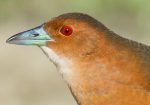
• Band-bellied Crake and Other Northeast China Specialties: Birding eastern Heilongjiang in May and June, the height of breeding season, our team noted Band-bellied Crake, found breeding Eurasian Eagle-Owl and Mandarin Duck, and recorded secretive species Rufous Hawk-Cuckoo and Gray’s Grasshopper Warbler.
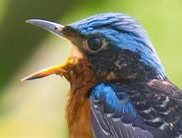
• Birds of the Remnant Manchurian Forest: Elaine Du and Craig Brelsford became the first birders to survey Wushun River National Forest Park in Elaine’s home county of Boli in eastern Heilongjiang. The duo noted 91 species around Wushun, among them Ural Owl and regional breeders Eastern Crowned Warbler, Radde’s Warbler, and White-throated Rock Thrush.
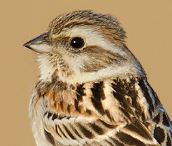
• Jankowski’s Bunting and Other Northeast China Species: A shanghaibirding.com research team found Jankowski’s Bunting in Inner Mongolia and counts of up to 600 Siberian Crane in Jilin. Tumuji wetland yielded Red-crowned Crane and Oriental Stork as well as flocks of hundreds of geese, and at Zhalong Nature Reserve in Heilongjiang the team had Swan Goose and White-naped Crane.
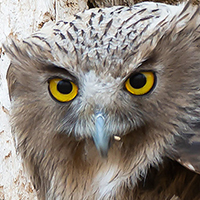
• Birding Siberia and the Russian Far East: Read our reports on Sikhote-Alin Nature Reserve, home of Blakiston’s Fish Owl; the Yamal Peninsula; and Kamchatka. For birders in Shanghai, an understanding of the birds of Siberia and the Russian Far East is crucial, as many species that are winter visitors and passage migrants in Shanghai breed in North Asia.
Featured image: Elaine Du (R) relaxes with son “Tiny” Craig Brelsford (C) and daughter Phoebe while birding in May 2024 at Wuying National Forest Park, Heilongjiang, China. (Craig Brelsford)


What a great, descriptive and thought provoking article, Craig! I appreciated the pictures of you and your family and respect teaching your children about your intellectual passion. Please keep up the good work
What a pleasure to read of your journey and success in seeing the Great Tit. The joy of having your children with you and the reconnection with Elaine’s (their) family comes through loud and clear. And what a wonderful opportunity for your children to experience their ancestral heritage, along with their father’s passion and expertise in birding and the natural world. Excellent photos and engaging narrative. Loved the photos of Tiny with his binoculars looking upward. And, wow, what a birthday gift to go to China! Good to read of your travels and sightings again
Great trip Craig. You made me homesick for China!